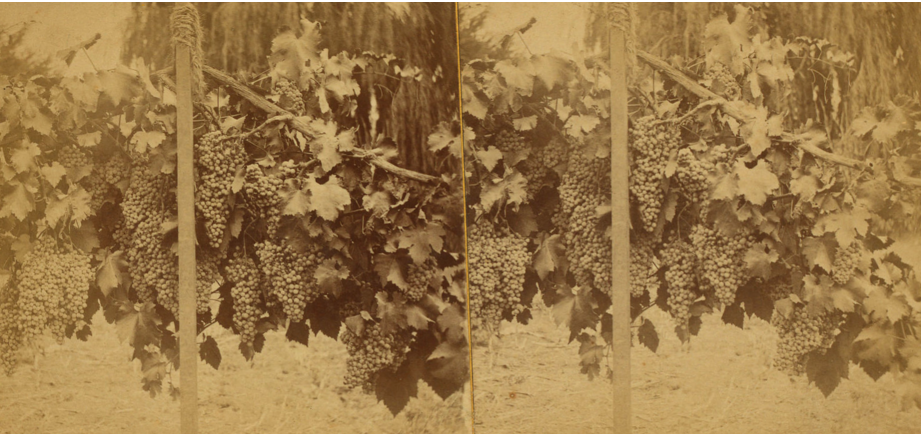The Twists and Turns of Sonoma County’s Mission Grape
By Virginie Boone
Before we had Pinot Noir, Chardonnay or Cabernet in Sonoma County, we had Mission. Its prevalence in Northern California was so profound, it was often simply known as the Sonoma grape, believed to have been brought originally by Russian settlers to Fort Ross in 1817.
It is also believed that Russians supplied Mission vine cuttings to the Mission San Francisco Solano in the town of Sonoma, the northernmost of the Spanish missions. There, Father Jose Altimira began planting vineyards in 1823, eventually producing 1,000 gallons of wine a year. But his vines fell into disuse by 1834, with the appropriation of the missions by the Mexican government.
But Sonoma County had a Mexican general who liked wine. General Mariano Vallejo replanted the vineyard in 1836, and by 1854, his 20,000 vines were producing an income of $20,000.
Vallejo’s brother started a vineyard east of Sonoma where Buena Vista eventually took root. In 1838 Vallejo granted his mother-in-law, a widow named Maria de Carrillo, the Rancho Cabeza de Santa Rosa, along Santa Rosa Creek, where she planted substantial vineyards and was known as Sonoma County’s first “feminine vineyardist.”
She surely would have planted Mission. Named for the fact that it was brought over by Spanish missionaries to be planted in California missions, the red Vitis vinifera grape was widely planted throughout the state from the time of its first planting by Junipero Serra in the mid 1700s at Mission San Diego de Alcala up until the phylloxera outbreak of the 1890s, when most of it was ripped out and replanted to different varieties, most of them French. Prohibition pretty well decimated any Mission that was left.
It long was suspected that Russian settlers brought Mission to Sonoma County from vines they picked up in Lima, Peru, sailing up and around the length of South America’s western coast.
This link was confirmed in 2007 when a genetic study by the American Society for Enology and Viticulture proved that the DNA of 52 ancient American grape varieties were identical to a grape variety known as Listan Prieto and that the current Peruvian Negra Criolla and California Mission are both genetically identical to Listan Prieto.
It is “with a high probability the one chosen by the Russian colonists to be taken to California,” states “The Peruvian Provenance of the Northern California Mission Grape,” published in 2020.
UC Davis’s Foundation Plant Services (FPS) confirms this research: “The Mission variety was introduced to California in 1778 and was the principal wine grape in the state until about 1870. In 2007, DNA analysis demonstrated that the grape known in California as Mission was the same grape as Listan Prieto, an ancient Spanish variety now restricted to the Canary Islands in Europe.”
FPS lists several Mission Selections found in California today, including Mission 17, from a very old vineyard in Santa Barbara County, reportedly planted in 1887.
Thick skinned, drought-resistant and high-yielding, Mission was made in a variety of styles, from sparkling to fortified. It is the grape used in a sweet high-alcohol wine known as Angelica.
It tastes somewhere between a Pinot Noir or Gamay. An 1867 report described Mission grown in Sonoma to produce “a soft wine, similar to a claret.”
A Petaluma Courier clipping from 1891 acknowledged its importance at the time, stating, “our well-known Mission Grape is an example of (the Franciscans) horticultural judgement, for it remains to this day the most valuable grape we have – a sort of survival of the fittest.”
The clipping describes how Mission makes “a fine amber white wine, a mild claret, a sweet wine – all suiting the American palate better than the rougher clarets.” The Mission vine is also described as “a strong, healthy grower, reaching great size and age and is enormously productive and suited to various soils.”
Despite its hearty versatility, Mission couldn’t survive Agoston Haraszthy’s plantings of 80,000 European vines at Buena Vista through the late 1850s and 1860s. The Hungarian-born Haraszthy had been sent to Europe to research the wine industry and came back with 200,000 rooted vines and cuttings of over 300 varieties, many of them ultimately preferable in taste to Mission.
This was an important development because before Haraszthy, viticulture had been suffering.
“For ten years beginning with 1845 the wine industry underwent a season of adversity,” reported the Cloverdale Reveille in 1912. “The confiscating of the missions resulted in many of the vineyards being ruined by neglect, and the gold fever which followed shortly afterward retarded development in every line of agriculture. Winemaking almost came to a standstill, but with the revival of agricultural pursuits it was one of the first industries to show progress and its commercial history dates from this period.”
In 1925 the Mission Grape “Comes Back,” according to the Cloverdale Reveille, who detailed, “one of the surprises of the season was the ‘come back’ of the Mission grape.”
Falling out of favor compared to many of the European varieties because “it only made a pink wine and, because of its lack of color, was not wanted by the ultimate consumer,” rain damage that year to the Zinfandel crop prompted a “wild scramble to fill orders for black grapes and buyers forgot all about their early objection and bought up Missions at better prices than anyone anticipated.”
But by the mid 1930s, Mission had fallen out of favor again, considered in a Press Democrat story to be “not satisfactory for the production of fine dry wines… lacking the delicacy and fragrance of the wines from France, Italy and Germany.”
And that’s where Mission has remained, largely forgotten, an inferior option compared with many of the varieties we know and love today. Across California, most of it is grown in the Fresno area, about 775 tons’ worth in 2022, worth an average of $331/ton. In Sonoma County, a mere 14.8 tons of Mission were crushed in 2022.
If you want to try some, your best bet is Scribe, who makes still and sparkling versions from estate-grown Mission grapes, some of the last Mission in the place where it was once synonymous.


